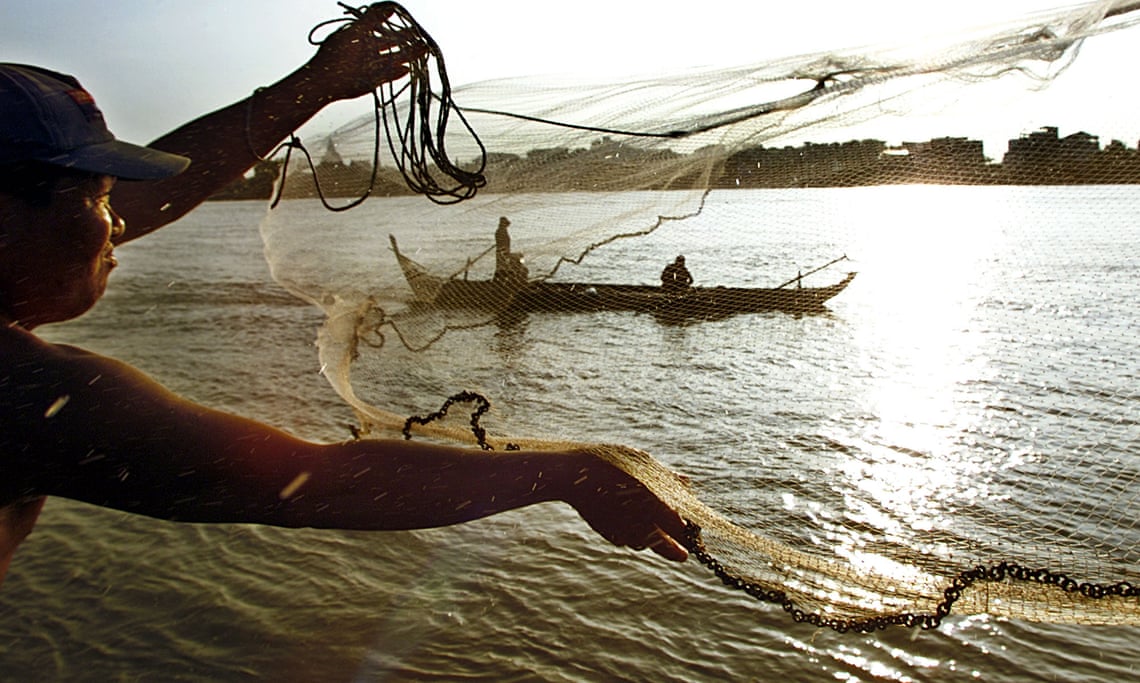Scientists warn that plans to build dams across Tonlé Sap, south-east Asia’s greatest lake, could be an ecological timebomb threatening the food security of millions

A Cambodian man casts his fishing net into the Tonlé Sap, one of the wonders of the aquatic world. Photograph: Andy Eames/AP
In a few months’ time, monsoon rains will more than quadruple the size of Cambodia’s Tonlé Sap, south-east Asia’s greatest lake and one of the wonders of the aquatic world. The huge flood will reverse the seaward flow of the river that feeds into the lake, submerge forests, make a perfect wetland for spawning fish and will replenish soils for a rich rice harvest.
Tonlé Sap is the most intensely-fished inland body of water in the world and as the annual flood subsides, many millions of fish will flow from it and back into the massive Mekong river where they will become the staple food of thousands of villages.
But this extraordinary annual cycle which has fed Cambodia’s 23 million people for centuries is fracturing as first China, and now neighbouring Laos and Thailand, prepare to build a series of great dams across the mighty Mekong and its tributaries to provide electricity for the region’s burgeoning cities. Eleven dams are planned to span the main river and nearly 100 more on its tributaries.
The dam builders and governments cite the need to reduce greenhouse gas emissions but what they don’t tell people is that the dams will slow the flow of the Mekong basin rivers and affect food supplies.
The Tonlé Sap, known as the beating heart of Cambodia, is liable not to flood, says Mark Goichot, a hydro-geologist working with WWF. “Most of Cambodia’s fish spawn is in Tonlé Sap lake, that is fed by the Mekong river. If less water comes downstream because of the dams, the lake will not flood as usual and the fish will not be able to migrate upstream, affecting the food supplies of millions of people. It is an ecological timebomb that threatens the food security of millions.”

A giant catfish in the Tonlé Sap Lake, Cambodia, the most intensely-fished inland body of water in the world. Photograph: Zeb Hogan/EPA
Now a paper in the journal Science from 39 leading aquatic ecologists warns that the Mekong, Amazon and Congo – the world’s three greatest and most biodiverse tropical rivers – all stand to be heavily dammed, possibly resulting in the loss of up to one third of all the freshwater fish in the world.
Tropical rivers are traditionally less dammed than those in temperate regions partly because they are mostly far from large human populations and are in places hard to access. But now, as demand for electricity soars across Africa, Latin America and the south-east Asia, it is increasingly attractive to develop hydropower.
In total, say the authors, over 450 large dams are planned for the three river basins. The consequences for food production is unknown, but it has been calculated that if 11 of the 12 mainstream dams are constructed on the Mekong, the total loss in fish could be between 550,000 and 880,000 tons a year. According to International Rivers, an environmental NGO, more than 100 species of fish in the region could face extinction.
The paper takes as an example of the gap between official promises and reality the Three Gorges dam across the Yangtze river in China. This was finished in 2012 at a cost of around $20bn and was justified by the government as providing 10% of all China’s electricity. In fact it generates under 2%.

Three Gorges dam across the Yangtze river in China has had a devastating impact on fish populations in the area. Photograph: China Daily/Reuters/Corbis
On the plus side, the biggest dam in the world has provided flood control, masses of electricity for cities like Shanghai and better river navigation. But on the debit side, it has had a devastating effect on fish populations, and led to increased erosion and landslides, and poorer water quality downstream. Moreover, it has forced over 1 million people to move and has spread disease. Now the Chinese authorities are having to spend up to $26bn over 10 years to mitigate some of the adverse environmental effects.
So are big dams worth it? The unprecedented building boom is widely justified as good for people because dams provide cheap electricity for development, and good for the environment because they are said to provide clean electricity and lower carbon emissions in a warming world. As such, they are likely to become more popular as countries try to meet the targets they set for themselves at the Paris climate summit in December.
The reality is that they are anything but climate-neutral and are responsible for large volumes of CO2 emissions from the concrete needed to build them, and for vast quantities of powerful methane gas emissions from the rotting of vegetation and soils flooded by their large reservoirs. By some calculations, the world’s 33,071 registered large dams may even produce 4% of all climate emissions.
The world is right to seek clean energy, but the unintended consequences of a rush to tropical hydropower may be as dangerous as climate change itself.
http://www.theguardian.com/global-development-professionals-network/2016/jan/08/wonder-of-the-aquatic-world-under-threat-from-plans-for-mekong-dams
